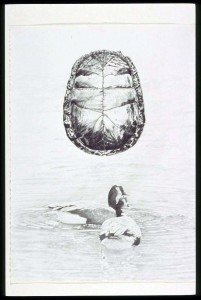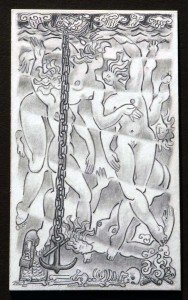Artists Chica Tenney and Robert Bricker
Streetlight’s second issue features the work of Virginia artists Chica Tenney and Robert Bricker. Tenney, a painter and multi-medium artist, and Bricker, a sculptor, generously share their thoughts on the philosophy and evolution of their work with Streetlight.

SL: How has your work evolved over time?
Robert Bricker: I have always been a figurative artist, whether it be drawing, sculpture, poetry, lyric or literature. My sense of composition has developed a lot. I do not let traditional proportion and anatomy interfere at all with the Rhyme Scheme of a composition.
Chica Tenney: It’s been so diverse. I started out with Abstract Expressionism, painting, and drawing. There were periods when I was younger where I was fascinated by film and books…I was so attracted to the photograph and yet I liked to to work from life. I did a lot of experimental work in that period, including print-making when our children were young. For the past 20 years — or maybe longer — I’ve been on my way back to painting and drawing. So that’s where I am at the moment.
SL: Have you developed a consistent theme or found yourself exploring new directions?
RB: Humor is an important theme, self-portrayal linked with ‘Protagonist as Fool’ is a constant. As a sculptor, I have a pass-key to many physical mediums. In terms of new directions, I preach; “…the next piece, the next piece, the next piece…”
CT: I think artists have a lot of curiosity, questions: what am I most interested in? what am I most attracted to make art? I was trying to understand why I’m fascinated by various things over the years. I think it has to do with energy and the energy that you feel from light on landscape, or particular people, usually creative people that I’m interested in drawing. There is a certain kind of energy and an inquisitive quality they have in their personality. Even objects — one’s attraction to objects, even things that have just been in your family a long time or things that are beautiful, they speak to you. And more and more I began to trust the idea of going with what attracts you to the moment; you feel strongly about and somehow wanting to encapsulate that, capture it. You know you can’t because everything is finite, but just for a moment. I was drawn back into painting because of its ability to connect…
SL: What have been your influences?

RB: In a phrase, Dave Hellman. Good luck looking up that arcane genius. Further, I have also spent 3 hours a day for 20 years studying the magnificent arts of Asia (primarily China and Japan).
CT: The one artist who has been a big influence for me was Avigdor Arikha. He was an Israeli who lived in Paris and showed in New York at Marlborough Gallery. Once I met Robert Hughes, the art critic, and he told me about Arikha. He was someone who believed in painting and finishing the painting all at once so there isn’t anything contrived about it. Your intellect can’t circumvent the feelings you have. He was really interested in the domestic world and the people in it. And other artists. We went to a couple of Arikha’s shows in New York and did meet him. He just died about two years ago.
SL: How have your subjects and mediums changed?
RB: My subjects are almost always improvised stream of consciousness. Medium shift takes a concerted effort and a willingness to make crappy art for quite a long while. Ceramics is very unforgiving in this respect. A lovely drawing going into a kiln can come out crashed and burned; an illegible shard. In order to survive the ceramic learning curve, I had to actually become titillated by the punishing contradictory results of Hope vs Reality.
CT: Earlier, I made very large drawings of people, other artists and their possessions, things in their orbit. Later, I began to work in a house down in Buckingham County that we had restored and I used that as a studio. Slowly the energy of the landscape began to be very powerful. I was painting still lifes in the empty interior of this place. I really began to look at the light in the spaces and to think a lot more about light. I looked across the river to the mountains, at how much they change and how much the feeling changes…every day…and then the seasons and so forth. I’d never imagined painting landscape other than as a background to something else. I still love combining landscape and still life.
See more of Tenney and Bricker’s work in Streetlight’s Art: Issue no.2, Summer 2012.
Art in Albemarle and Beyond…
For photography enthusiasts, this summer promises to be a bonanza, near and far.
Charlottesville’s Festival of the Photograph, Look3, opened June 1st and exhibits will run until early July. Check out Donna Ferrato’s provocative images at the McGuffey Arts Center, Camille Seaman’s spectacular icebergs at Chroma and David Doubliet’s dramatic underwater shots hung high in The Trees along the downtown Mall.
The Virginia Museum of Fine Arts, Richmond: Visions of France can be seen through July 8th. French photographers Robert Doisneau and Édouard Boubat, and American Joel Meyerowitz display their images of France, particularly Paris, the “cradle of street photography.”
The National Gallery, West Wing, Washington, D.C.: I Spy: Photography and the Theater of the Street, 1938–2010 will be shown until August 5th. On view are some 90 works of American street photography shot by masters Harry Callahan, Bruce Davidson, Philip-Lorca diCorcia, Walker Evans, Robert Frank and Beat Streuli.
The Metropolitan Museum, New York: Naked Before the Camera, runs through September 9th: This small scale, intimate exhibit surveys nude photographic studies from the Victorian era to the present.
–Elizabeth Meade Howard, Art Editor
Follow us!Share this post with your friends.

I wish you wrote more about your evolution as a writer. . . .